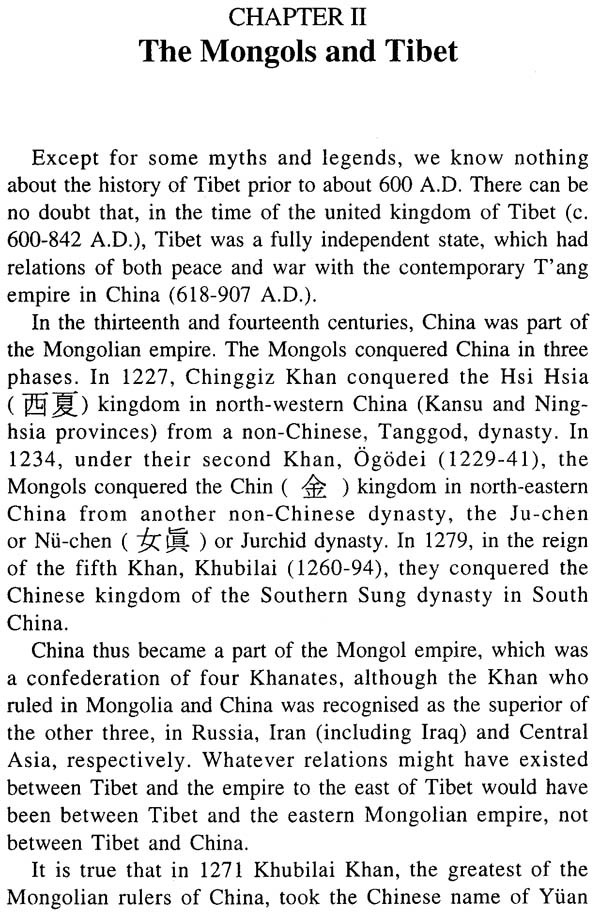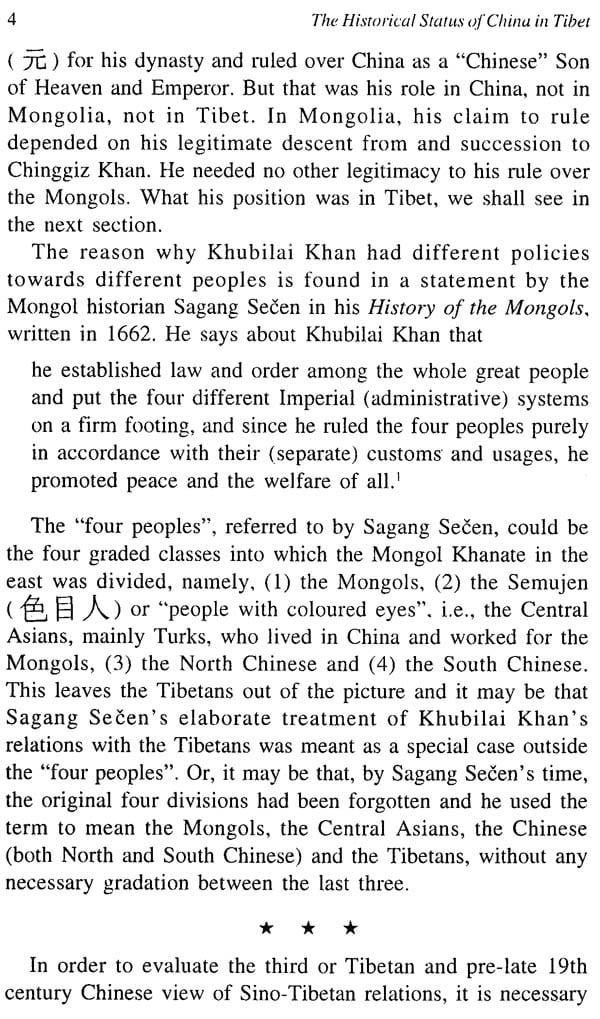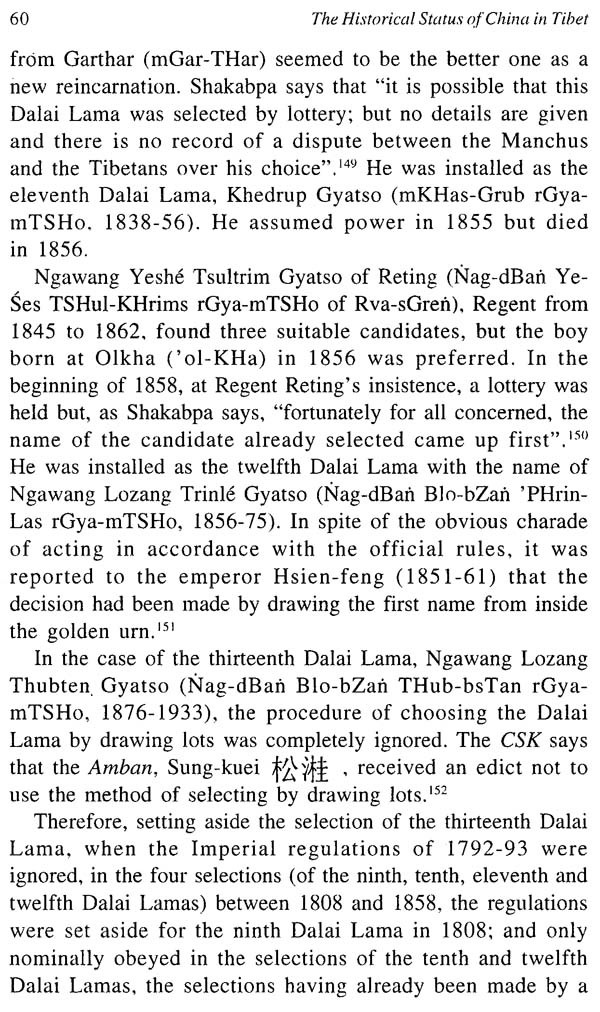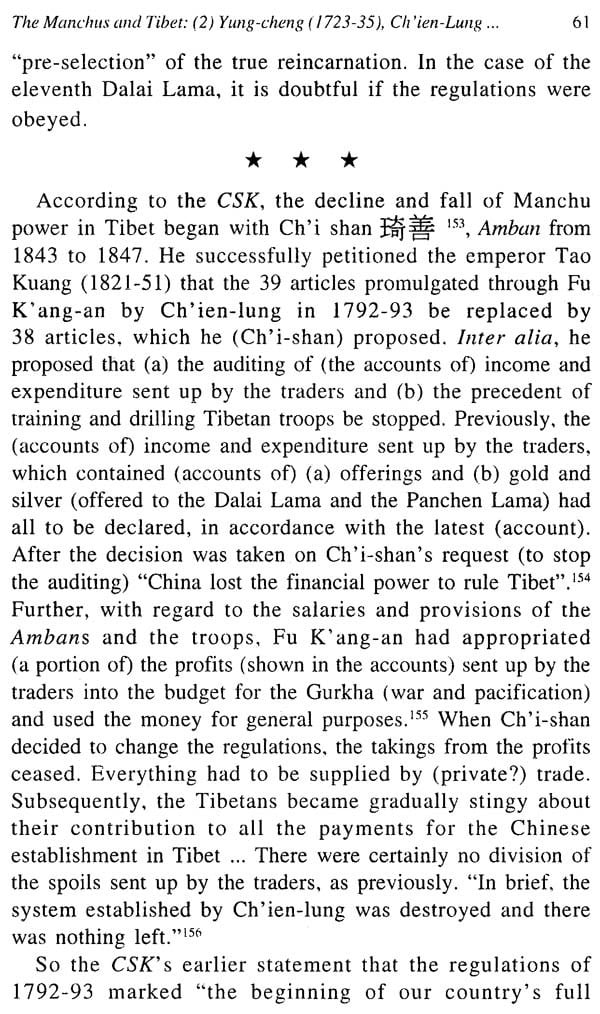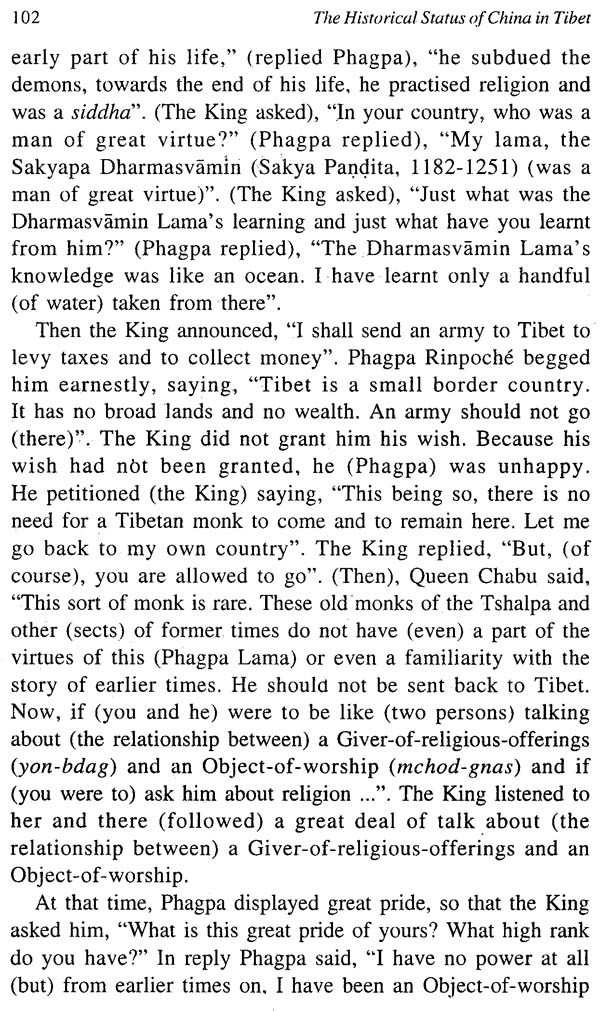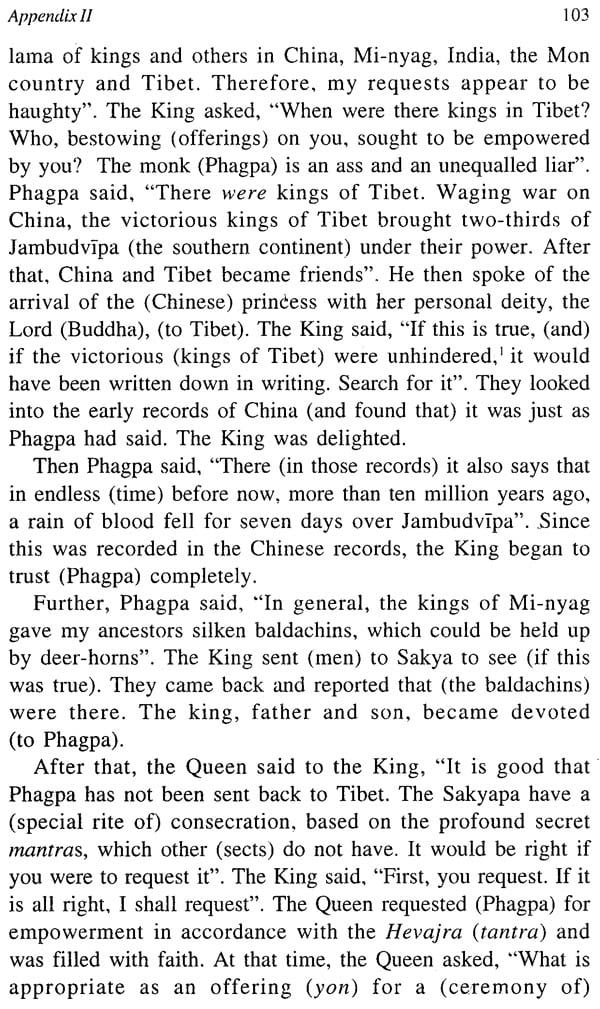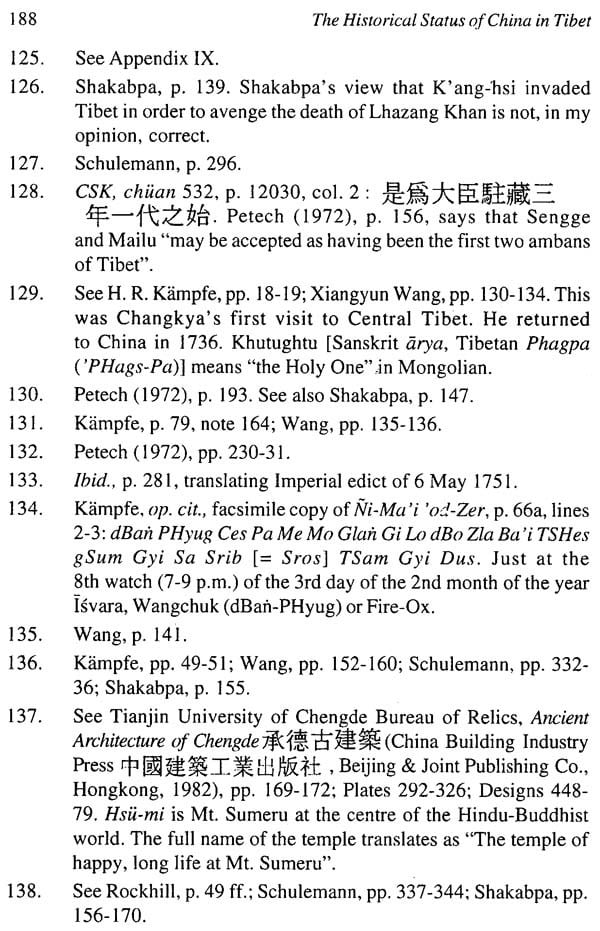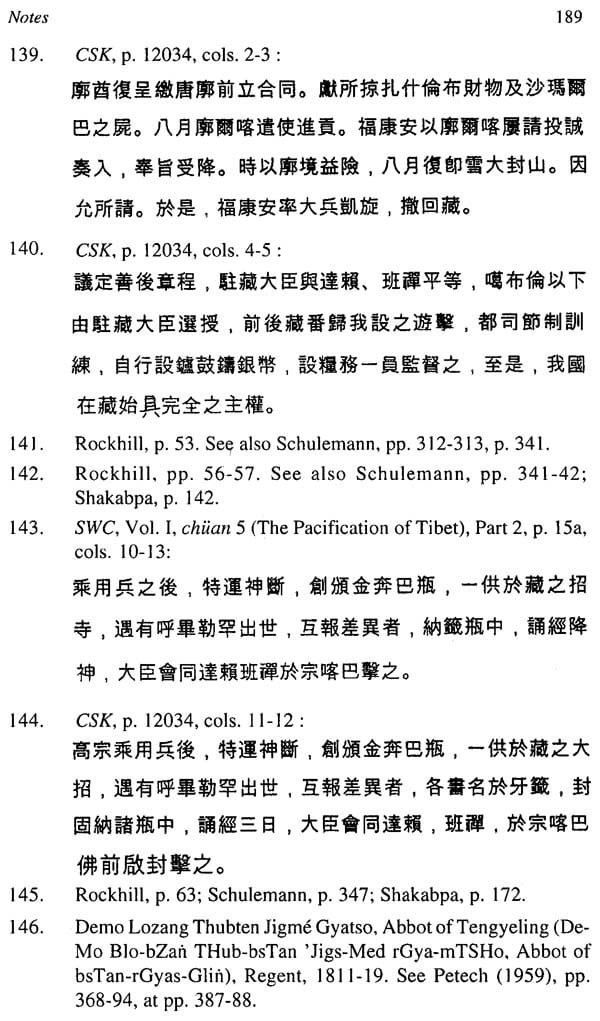
The Historical Status of China In Tibet
Book Specification
| Item Code: | NAD820 |
| Author: | Zahiruddin Ahmad |
| Publisher: | Aditya Prakashan |
| Edition: | 2012 |
| ISBN: | 9788177421118 |
| Pages: | 227 |
| Cover: | Hardcover |
| Other Details | 8.5 inch X 5.5 inch |
| Weight | 410 gm |
Book Description
The History of Tibet by Nag-dBan Bio-bZan rGya-mTSHO, the fifth Dalai Lama of Tibet (1617-82), was completed on 14 November 1643. It celebrates the Dalai Lama's coming to power in Tibet in 1642. He sees this event as a new spring in the history of Tibet, to celebrate which he wrote The Song of the Queen of Spring or A History of Tibet.
The notes by the translator, Zahiruddin Ahmad, add to our understanding of the text. For instance, while commenting on the relationship established between the Mongolian Qubilai Qagan (reigned 1260-94) and the 'Phags-Pa Lama (1235- 80), the seventh head of the Sa-sKya-Pa sect of Tibetan Buddhism - the translator shows (in Notes 734 and 739) that the relationship was essentially a personal, religious one. This means that the present-day Chinese claims to "Chinese sovereignity" - or even "Chinese suzerainty" - in Tibet "since the thirteenth century" are not supported by historical facts.
In this book, the author examines the claim, made by the British in the 19th120th centuries, that China was suzerain (but not sovereign) in Tibet; and the counter-claim, made by the Chinese, that China was sovereign (not suzerain) in Tibet, at least since the 13th century.
The author shows that neither of these two propositions is historically correct. In the 13th/14th centuries, when China was part of the East Asian Mongol Empire, a personal, religious relationship was established between the Mongol Khan (not the emperor of China) and the principal lama-ruler of Tibet, namely, the head of the Sakyapa sect of Tibetan Buddhism. Briefly, it was a relationship between the Khan as the Giver-of-religious offerings and the deity (Hevajra) incarnate in the body of the lama as an Object-of- worship.
During the Manchu Ch'ng dynasty (1644-1912), the personal, religious relationship was revived between the Manchu emperor and the new heads of the Tibetan state, namely, the Dalai Lamas of Tibet, the reincarnations of A valokitesvara.
This thesis is supported by 9 appendices, which are translations of Chinese, Tibetan and Mongolian historical documents.
Zahiruddin Ahmad was born in Calcutta, India, and educated in Calcutta, London and Oxford universities. From 1969 to 1995, he taught at La Trobe University, Melbourne, Australia. In 1988-89, he was Visiting Professor at the Seminar fur Sprach- und Kulturwissenschaft Zentralasiens (Department of Central Asian Studies) at Bonn University, Germany. He is the author of (1) Sino-Tibetan Relations in the Seventeenth Century (Rome, Istituto Italiano per il Medio ed Estremo Oriente, 1970. Serie Orientale Roma, 40), (2) A History of Tibet by Nag- dBan Blo-bZail rGya-mTSHo, Fifth Dalai Lama of Tibet, translated from Tibetan, (Indiana University, Research Institute for Inner Asian Studies, Bloomington, Indiana, 1995. Indiana University Oriental Series, 7) and (3) Sails-rGyas-mTSHO, Life of the Fifth Dalai Lama, Vo l. IV, Part I, translated from Tibetan (New Delhi, International Academy of Indian Culture & Aditya Prakashan, 1999. Satapitaka Series, 392)
In this book, I have examined the claim, made by the British till their departure from the South Asian scene in 1947 and even after that, that China was suzerain (but not sovereign) in Tibet; and the counter-claim - very much of a counter-claim - made by the Chinese since the late 19th century that China was sovereign (not suzerain) in Tibet. Indeed, as put forward by the Chinese communists, the claim is that China has always been, or been since the 13th century, sovereign in Tibet.
My researches into the history of Sino-Tibetan relations have led me to the conclusion that neither of these two propositions, claim and counter-claim, is historically correct. In the 13th/14th centuries when China was part of the East Asian Mongol empire, there was a personal religious relationship between tlie Mongolian Khan and the principal lama-ruler, the head of the Sakyapa (Sa-s Kya-Pa) sect, in Tibet. Briefly, it was a relationship between the Khan as the Giver-of-religious-offerings [Tibetan Chinda (sByin-bDag), Mongolian, Chinese Shih-chu and the deity incarnate in the body of the lama as the Object-of- worship [Tibetan Chane (mCHod-gNas), Mongolian Morgylyn orun] and the recipient of these religious offerings. This personal, religious relationship between the Khan and the Sakyapa lama cannot be interpreted as either "Chinese suzerainty" or "Chinese sovereignty".
During the Ming dynasty (1368-1644), the Chinese emperors conscientiously played the role of Givers-of- religious-offerings not only to the head of the Sakyapa sect, but also to the heads of the Karmapa, Drigungpa CBri-Gun- Pa) and Tagtsangpa (s'Tag-T'Sl-lan-Pa) sects; Chamchen Choje (Byams-CHen CHos-rJe), an eminent monk of the Gelugpa (dGe-Lugs-Pa) sect; the secular Phamodrupa (PlIag-Mo-Gru- Pa) hegemons of Tibet; and the lama-rulers of two small
Sakyapa estates in Eastern Tibet - in all, eight personages. Thanks to the emperor's generosity, the "giving of religious offerings" was wholly to the advantage of the Tibetans. Chamchen Choje, for instance, received enough gifts during his first visit to the Imperial court in 1414-16 to be able to found Sera monastery in 1418-19.
In the time of the Manchu Ch' ing dynasty (1644-1912), the old personal, religious relationship, which had existed between the Mongol Khans and the Sakyapa lamas, was consciously revived between the Manchu emperors of China and the new heads of the Tibetan state, namely, the Dalai Lamas of Tibet. In 1721, the emperor K'ang-hsi acknowledged that his two predecessors had been and he himself was nothing more or nothing less than Givers-of religious-offerings to the Dalai Lama. Whatever authority the Manchus had in Tibet - even at the height of that authority in the closing years of, the emperor Ch'ien-lung (1736-96) - was within the framework of that religious relationship. And 'whatever authority the Manchus had in Tibet disappeared by the middle of the 19th century.
As for the sources of this book: For Chapter II, my main guides have been Professor Dieter Schuh's Erlasse und Sendschreiben Mongolischer Herrscher fur Tibetische Geistliche (1977) and Professor Luciano Petech's Central Tibet and the Mongols (1990). With 'this guidance, I have studied the short notice on the Phagpa Lama (1235-80) in chuan 102 of the Yuan shih (History of the Yuan dynasty) (Appendix I) and parts of three 17th century Tibetan and Mongolian chronicles, namely, the Sa-sKya-Pa'i glsun-Rabs (SDR, Dynastic History of the Sakyapas, 1629) (Appendices . II-IV); the History of Tibet (HT) by the fifth Dalai Lama (1643); and the History of the Mongols by Sagang Secen (1662) (Appendix V).
Chapter III is based almost wholly on chuan 331 of the Ming shih (History of the Ming dynasty), the relevant portion of which has been translated in Appendix VI.
In Chapters IV and V, as far as the 17th century is concerned, I have relied on my earlier work, Sino-Tibetan Relations in the Seventeenth Century (1970). For the first half of the 18th century, my main source of information was Professor Petech's China and Tibet in the early XVIlIth century (2nd Edition, 1972) but in Chapter IV, I have added two edicts of the emperor K' ang-hsi, with dates corresponding to 7 November l719 and 18 November] 721 - that is, before and after the invasion of Tibet in 1720 - which I regard as important (Appendices VIII - IX). The main Chinese sources for Chapters IV and V are selected documents from the Ch'ing shih kao, the Ch'ing shih kao and the Sheng wu chi (1842).
The sources of Chapter VI and the Epilogue have been mentioned in the first paragraph of Chapter VI. The reader is referred to the Bibliography for full details of all my sources.
For transcribing Chinese words, I have used the Wade-Giles system of transcription. I have transcribed Tibetan names more-or-less as they are pronounced but, at the first mention of these names and in the Index, I have given the Tibetan spelling (within brackets) according to the following system of transcription:
| K | KH | G | N |
| C | CH | J | N |
| T | TH | D | N |
| P | PH | B | M |
| TS | TSH | DZ | V |
| Z | Z | Y | |
| R | L | S | S |
| H | A |
For the Mongolian script I have followed the system of transcription in Ferdinand D. Lessing's Mongolian-English Dictionary, with the following changes: I', y changed to gh; X changed to kh: and Z changed to J.
I owe my special thanks to the Far Eastern Collection of Melbourne University Library (The Baillieu Library), without whose ample resources and the unfailing helpfulness of whose librarians-in-charge, this book could not have been written.
It was in March 1959 while listening to the SHC broadcasts on the rebellion in Tibet, that I became interested in that country, its history, religion, etc. With this, my sixth book on the subject of Tibet, I bring my Tibetan studies to a close. I thank Aditya Prakashan for publishing this book.
| Preface | IX | |
| Chapter I | Introduction | 1 |
| Chapter II | The Mongols and Tibet | 3 |
| Chapter III | The Ming Dynasty of China (1368-1644) and Tibet | 12 |
| Chapter IV | The Manchus and Tibet: (1) Shun-Chilh (1644-61) and K'and-his (1661-1722) | 29 |
| A.Shun-Chih(1644-61) | 29 | |
| B.K,ang-his (1661-1722) | 31 | |
| 1. Wu San-Kuei | 31 | |
| 2. Galdan Hungtaiji | 34 | |
| 3. Tsewang Rabten | 40 | |
| Chapter V | The Mauchus and Tibet: (2) Yung-cheng (1723-35), Ch'ien-lung (1736-96) and the early 19th century | 50 |
| A.Yung-cheng (1723-35) | 50 | |
| B.Ch'ien-lung (1736-96) | 51 | |
| 1. 1750-51 | 51 | |
| 2. 1757-60 | 52 | |
| 3. 1780 | 53 | |
| 4. 1792 | 53 | |
| C | The early 19th Century | 58 |
| Chapter VI | British Policy in Tibet | 67 |
| 1.1861-73 | 67 | |
| 2. 1876 | 69 | |
| 3. 1884-86 | 69 | |
| 4. 1886-1890/93 | 71 | |
| 5. 1890/93-93 | 73 | |
| 6. 1899-1904 | 75 | |
| 7. 1904-14 | 77 | |
| 8. 1904-13 | 78 | |
| Epilogue | 84 | |
| Appendix I | From the Yuan Shih | 97 |
| Appendix II | From the Sa-sKya-Pa'I gDun-Robs (SDR) | 101 |
| Appendix III | Khubilai Khan's Edict in the Tibetan language (1254) | 109 |
| Appendix IV | Khubilai Khan's "Pearls Edict" (1264) | 113 |
| Appendix V | From Sagang Secen's History of the Mongols | 117 |
| Appendix VI | From the Ming Shih | 123 |
| Appendix VII | From the Ch'ing Shih lu (29 December 1692) | 161 |
| Appendix VIII | From the Ch'ing Shih lu (7 November 1719) | 165 |
| Appendix IX | From the Ch'ing Shih lu (18 November 1721) | 167 |
| Abbreviations and Bibliography | 169 | |
| Notes | 177 | |
| Index | 197 |
